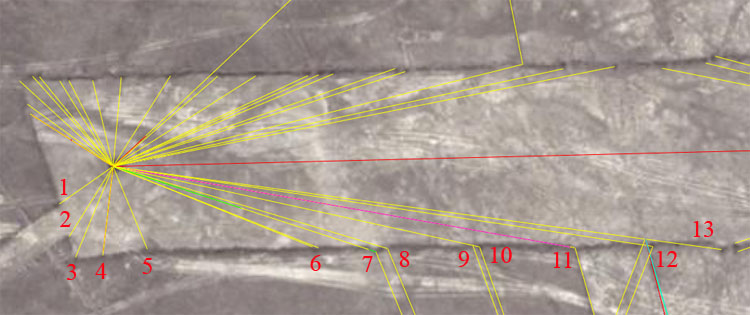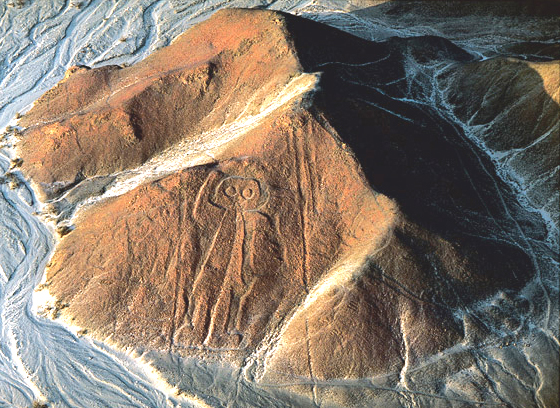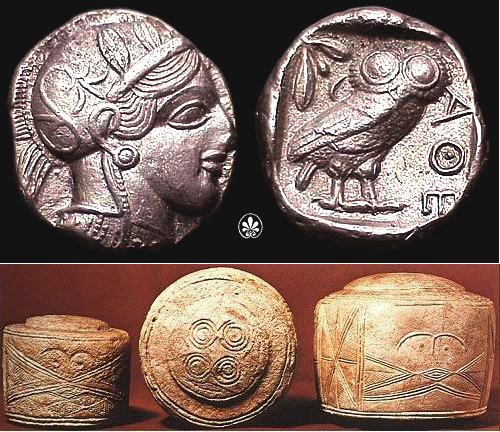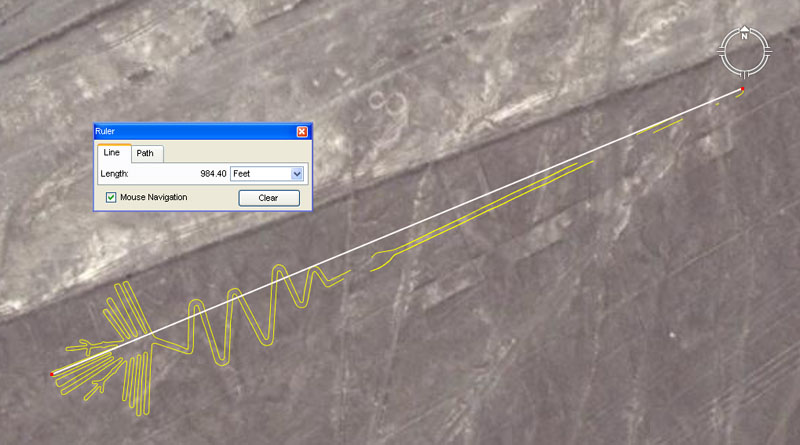
THE WESTERN CAIRN

We will now give the length and angles from the cairn to these numbered stations where markers are seen or from whence secondary lines commence.
1. The distance is 76.8-feet and the angle back to the cairn is 55-degrees.
The 76.8 values is a part of a very important navigational mathematical progression which goes: 76.8, 153.6, 230.4 (note: The square footage value for each face of the Great Pyramid was 230400), 307.2, 384, 460.8, 537.6, 614.4, 691.2 (note: In the reading of the equatorial circumference as 24883.2-miles ... either Greek or British... 69.12-miles would be 1-degree of arc).
The angle back to the cairn of 55-degrees relates to the "11" family of values including the British Mile, which is 55 X 96-feet or 960 fathoms of 5.5-feet = 5280.
2. The distance is 97.2-feet and the angle back to the cairn is 32-degrees.
The value of 97.2 is integral to one of the most important navigational and lunar mathematical progressions of antiquity. It goes: 97.2, 194.4, 291.6, 38.88, 486, 583.2, 680.4, 777.6, ...1166.4....1555.2... 2332.8 ... 3110.4, etc. It's of interest to note that the Greeks used this progression in fashioning their volume standards for liquids and dry goods. Their "Liquid" Metretes was 2332.8 cubic inches, whereas their Chou was 194.4 cubic inches. In the "Dry" goods standard the Medimnus was 3110.4-cubic inches. The value for a Medimnus X 8 = 24883.2 or the value used to describe the equatorial circumference in miles. It is worthy to note that the ancient navigational and cyclic-astronomy numbers of the Mediterranean-European cousin nations will ALWAYS show up in their volume measures used in the marketplace.
The angle is 32-degrees and this value is very important within a 360-degree circle. For example, 1/32nd of a 360-degree circle is 11.25-degrees, doubling to 22.5, 45, 90, 180 & 360. The mathematical progression based upon 32 is very important to navigational and lunar calendar calculations. A Druidic breastplate medallion recovered from the neck/ chest area of an ancient skeleton at Kingston, Barham Downs, England was calibrated to 32 positions on the outer rim. This is similar to a number of ancient circular designs found in both North and South America, where the outer rims were calibrated to 32 and thereby inferred compass devices of 320-degrees. In using all 64 squares (32 X 2) of the Calendar of Coligny to achieve a reading of 1890-days of passage, it equates to exactly 32 double lunar months.
3. The distance to this corner of the rectangle is 115.2-feet and the angle back to the cairn is 22.5-degrees.
The distance codes the very important navigational mathematical progression based upon 115.2, which goes: 115.2, 230.4, 345.6 (note: the outer rim sweep of the Sarsen Circle was 345.6-feet or 30 X Sarsen horizontal lintels of 11.52-feet each), etc. The value relates to the equatorial size of the Earth.
The angle is merely coding 1/16th part of a 360-degree circle.
4. The distance is coding 105-feet (100 Greek-feet or 10 Hebrew Reeds) and the angle from the cairn to this position is 186.624-degrees.
The value of 10 Hebrew Reeds would be 1/50th of a Greek mile of 5250-feet. It is very likely that this distance would have been pegged to offer a second coded reading of 101.376-feet or 1-second of arc in a reading of the Earth's equatorial circumference of 24883.2 British standard miles of 5280-feet each.

The glyph at Nazca known variously as the "Owl-Man"
or "Astronaut" adorns the side of a hill and has been deliberately
fashioned in this more upright manner so that it can be seen from a wide expanse
of the desert floor. It seems to have been in a direct line of sight from the
temple-pyramid complex at Cahuach, 5.6-miles southwards. The Owl-Man's official
length is 32 metres, which translates very fluidly to 105 British feet (100
Greek feet of 12.6-inches each or 10 Hebrew Reeds
of 10.5-feet each).
Throughout the ancient Mediterranean and Europe, Owl-eyed
or Owl "shape-changer" goddesses were revered, including Athena
of Greece, Minerva of Rome or Blodeuwedd
of Wales, etc. All such goddesses were renown for their great wisdom. Owl-eye
symbolism, similar to that depicted at Nazca, is found in pictographs from Romania,
to Ireland, to the Columbia River Basin and California in North America, to
several locations in South America, to Easter Island (where there are multiple
examples), to the wide-eyed and duplicate head form found on "Tiki"
artefacts of New Zealand.

Top picture: In European culture the owl has always been venerated as the keeper of wisdom and this tradition is traceable back to Athena, who, in Greek mythology, was the virgin goddess of arts, crafts, sciences and war strategy. The very wise Athena was represented as having large owl-like eyes and she wore a helmet bearing an owl symbol. The owl was a protected bird in ancient Greece and large numbers of them occupied the Acropolis. Two "capacity marked" earthenware vessels were found at the bottom of a well at the Acropolis. Of these, one was marked as a public standard Khous (194.4 cubic inches) and bore the official "owl" stamp of Athens, attesting to the integrity of its measure. The second item was an official water clock, marked as two Khous (note: 1944 was a highly important, factorable ancient value that is positively represented in the geometry of Nazca). In Greek mythology owls were the messengers of Hecate, goddess of witches and sacred to Persephone, goddess of prophecy.
Bottom Picture:
The Folkston drums, taken from a child's grave of the "Wessex or Beaker"
people of Neolithic England. Their design work and cultural symbolism is duplicated
by the ancient "Lapita" people of the Pacific, who lived contemporaneously
to the Wessex people and had advanced navigational skills that allowed them
to range across the entire expanse of the Pacific Ocean.
According to the Welsh Mabinogi, the May Queen, Blodeuwedd,
had formerly been human, but had been turned into an owl. In ancient New Zealand
culture the owl, or Ruru, was the guardian of knowledge
and a person nearing death would hear the owl call out his or her name when
it was time to die. The same near death tradition is harbored by North American
Indian tribes.
In ancient Greek representations of Athena, she is often seen to have one arm raised (frequently with an owl standing aloft) and to carry a round shield in the other, in a similar stance or fashion to what is seen in this Nazca glyph. There is much to suggest that the "Owl Man" is actually an image of Athena, based upon the glyph's very "Greek" length of 100 Greek feet and the fact that there is a Phoenician (Punic)-Greek script nearby at Palpa Mountain. The Greek alphabet was based upon the earlier Phoenician alphabet. Also, students working hard to learn & memorise the sciences encoded into the pampa could have no better, ever-watchful, owl-eyed and alert overseer than the very wise Athena, spurning them on to greater levels of achievement.
The angle in this case was coded to represent 186.624 (1866 & 6/25ths ÷ 10). Again the angle is representative of a mathematical progression that relates to the equatorial size of the Earth in feet, according to the Great Pyramid's literal dimensions. The progression goes: 186.624, 373.248, 559.872, 746.496, 933.12 (note: there would be 140000 increments of 933.12-feet in the full equatorial value),... 1306.368 (note: there are 130636800-feet in the equatorial circumference under this system), 1492.992, etc.
It's interesting to note that this progression of numbers was adopted by the Romans when fashioning their "Liquid" volume system, in which the cubic inch capacities were: Sextarius…31.104 cubic inches ( 1/6th of 186.624), Congius…186.624 cubic inches, Urna…746.496 cubic inches, Amphora …1492.992 cubic inches. The Romans, like the Greeks, adopted the earlier systems of the cousin nations, especially systems still in use in Egypt.
Another value that occurs in this mathematical progression is 93312 and the ancient Babylonians - Sumerians used this value in their weights system for the "Royal Double Standard" wherein their "Talent" was 933120-grains. Under their "Royal Single Standard" the Talent was half that value at 466560-grains (note: the term "grain" means one grain of wheat from a normal, healthy crop).
5. The distance is 108-feet and the angle, in this instance is 337.5-degrees return to the cairn.
Again it's probable that a peg on the line also coded a distance of 105-feet. As stated the 108-value is very important to a progression of numbers from which navigational, solar, lunar, Precession of the Equinoxes and Sabbatical Calendar values are derived.
The degree angle of 337.5 denotes a value that was very important to lunar calculations and the dimensions of the Khafre Pyramid (Egypt's Pyramid of the Moon), as well as navigation under the Great Pyramid's literal system. The progression goes: 337.5, 675, 1012.5, 1350, 1687.5, 2025, 2362.5, 2700,... 4725, etc. Again, values within this progression feature in the ancient "Weights and Measures" of the Mediterranean and Europe. For example: The Roman Libra, used in their gold standard, was 4725-grains. Likewise, the design height of the Khafre Pyramid was 472.5-feet, which, in days, would equate to 16 lunar months of 29.53125-days each (29 & 17/32nds).
6. The distance is 252-feet to the western side of this "hump-bridge" position and the angle from the cairn to this position is 112-degrees.
The value of 252-feet would be 1/3rd of the length of the Great Pyramid @ 756-feet per side. It would also equate to 24 Hebrew Reeds, 120 Assyrian Cubits, 240 Greek feet, 144 Celtic Royal Cubits, etc. The sum of 252-feet = 3024-inches and the perimeter of the Great Pyramid was 3024-feet for 1/2 a minute of equatorial arc. There would be 27 periods of 252-days in the lunar nutation cycle of 6804-days. The Greek stadia length was 630-feet or 252-feet X 2.5, etc.
The angle is 112-degrees and this forms a very important navigational progression, based upon the Great Pyramid's standard. There would be 27 intervals of 112-feet in the 3024-feet perimeter of the Great Pyramid.
The position seems to be dual coded, with yet another length and degree angle to be extracted from the eastern side of the hump. The distance here measures out to be 259.2-feet @ 291.6-degrees return angle to the cairn. The 259.2-feet length is also encoded into Stonehenge and represents the distance from the centre of the site to the rear face of the Heel Stone. It appears to have been the design length up the side of Silbury Hill (artificial mound) adjacent to Avebury Henge in Southern England. The Precession of the Equinoxes was calculated to endure for 25920-years to complete one cycle. In this duration of years, the sun would rise for 2160-years in each of the 12 Houses of the Zodiac, when the rise was observed on the day of vernal equinox. Precession threw calendars out by 1-day each 72-years and periodic adjustment had to be done to maintain accuracy concerning exactly which day constituted the vernal equinox.
The merits of a mathematical progression based upon the value 291.6 have already been discussed. The sum of 291.6-feet would be 300 Roman feet of 11.664-inches or 60 Roman Paces. There would be 134400000 Roman feet in the Great Pyramid standard for the equatorial circumference of the Earth or 26880000 Roman Paces.
7. This length to another of the bridge-humps, where a major secondary line begins, is probably dual or triple coded. The overall length is 320-feet @ 108-degrees from the cairn.
Other incorporated length codes, pegged out along the line, were probably 315-feet (half a Greek stadia) and 314.6-feet (coding a symbolic value for PI). The merits of 320 & 108 have already been discussed.
8. The distance is 336-feet and the angle is 106.666666-degrees.
The value 336 is very important to navigation by the Great Pyramid's literal standard. A mathematical progression based upon this value goes: 336, 672, 1008 (note: under the Great Pyramid's geodetic system, 1-second of Earth equatorial arc was 100.8-feet), 1344, 1680, 2016, ... 3024 (the Great Pyramid's perimeter value for one circumnavigation...1/2 a minute of arc), etc.
The angle value of of 106.66666 (106 & 2/3rds) is an expression of 320 (1/3rd).
9. The distance to a point where a secondary line commences is 432-feet and the angle from the cairn is 102.4-degrees.
The value 432 sets up a mathematical progression that was important to ancient navigation, the Precession of the Equinoxes and calendar computations. The progression goes: 432, 864 (the sun is 864000-miles in diameter), 1296 (the Babylonian Archane volume was 129600 cubic inches) , 1728 (the longer of the Egyptian Royal Cubit set was 1.728-feet... the distance around Silbury Hill was designed to show 1728-feet ... a cubic foot of water is 1728 cubic inches ... the Great Pyramid has a perimeter value of 1728 Celtic Royal Cubits of 21-inches each), 2160 (the sun spends 2160-years in each House of the Zodiac during the cycle of Precession ... the British Bushel was 2160 cubic inches ... the Sumerian/ Babylonian Homer volume was 21600 cubic inches), 2592 (the cycle of Precession endures for 25920-years ... the Heel stone is 259.2 feet from the centre of Stonehenge), etc.
The angle is 102.4-degrees (based upon 3.2 or 6.4) and this value sets up a navigational progression related to the equatorial circumference of 24883.2-miles. One of the values derived from this progression is 10137.6 and 1-second of arc (under a circumference of 24883.2-miles of 5280-feet each) is 101.376-feet.
The long-suffering reader will be getting the idea by now that all values encoded at Nazca form "strings" of numbers that culminate into dynamic mathematical progressions, used to describe the profound navigational and astronomical sciences of the ancient cousin nations. When one does not have endless reams of perishable paper for the repetitive production of books and laborious transcriptions of more ancient texts, then enduring landscape geometry fulfils the role and encodes the sciences admirably for all the generations to come.
10. Position 10 is merely an extension of 6-feet to the 432-feet line, giving us a value of 440 feet.
From this point a secondary line commences. The 440 value is indicating the "11" series of numbers and a British mile of 5280 feet is 440-feet X 12. The Great Pyramid was 440 Egyptian Royal Cubits of 20.61818182-inches, or if symbolically elongated to comply to the "11" family of numbers, a 1/440th increment produced a Royal Cubit of 20.625-inches.
The angle code remains the same.
11. This position would, conceivably, also be dual coded as 544.32-feet and then (with a second peg or station mark) 550-feet.
The angle back to the cairn is 280-degrees. The distance of 544.32-feet would be 1/2 the distance between the eastern and western surveying cairns. It will be recalled that the 1088.64-feet distance between the cairns was 13063.68-inches, in deference to the 130636800-feet equatorial circumference (Great Pyramid standard).
The 550-feet is a part of the "11" family of numbers in the mile of 5280-feet and there would be 9.6 increments of 550-feet (100 old English fathoms) in a mile. One cross diameter of the "purpose-built" Silbury Hill in Southern England is 550-feet, coding a circumference of 1728-feet. The other cross measure of Silbury Hill gives a value of 525-feet (1/10th of a Greek Mile), creating a circumference of 1650-feet. Professor Alexander Thom commented how British circle sites were often elliptical to carry two diameters, 90-degrees opposed to each other. Each diameter carried it's own code. For example, one cross measure of the inner lintel faces at Stonehenge is 100-feet (coding PI related values in the circumference). The other cross measure is 100.8-feet, which is 1-second of Earth equatorial arc according to the Great Pyramid's literal standard. If this value is multiplied by PI @ 22/7ths (3.142857143) = 316.8-feet (480 links of 7.92-inches each). The value is at the basis of an "11" family mathematical progression that relates to the mile of 5280-feet and two separate navigational systems that used that mile.
With regards to the dual diameters of Silbury Hill: It offers two specialised navigation tutorials by reference to these diameters. The same tutorials are taught at Nazca in Peru. These are:
Therefore: 525-feet X 3.142857143 = 1650-feet (note: the ancient English Rod or Perch was 16.5-feet and the ancient league was 16500-feet or 3.125-miles).
Therefore: 550-feet X 3.141818182 = 1728-feet. If this value is divided by 360-degrees then each degree of arc is 4.8 feet or 1.2-feet X 4.
These two means of converting linear distances to whole number circumferences were at the heart of the most used navigational systems and degree angle finding methodologies of antiquity. These two windows of opportunity for manipulating the complex value of PI into useful, factorable circumferences made accurate navigation and positional plotting possible across the vast, featureless oceans. Calculating correct degree angles to destinations or locations of dangerous shoals and rocks was the difference between life or death at sea in any voyage, as the ocean does not abide fools well, nor compensate for one's lack of experience.
The angle in this instance is 280-degrees and this value was highly important to the Sabbatical Calendar. Under the simple agrarian or peasant system of counting, each week was 7-days and there were 28-days in each month X 13 months per year for 7 full solar years. At the end of the 7th or Sabbatical year there was a festival to use up the 8.75-days of deficit and the next Sabbatical period commenced anew, fully corrected.
12. The distance is 640-feet and the degree angle from the cairn to this station is 98.4375-degrees (98 & 7/16ths).
The distance is self-explanatory as an expression of 320. A 360-degree circuit ÷ by 640 = 9/16ths per degree or .5625. A mathematical progression based upon this angle value delivers up a whole raft of very useful lunar and navigational codes. Three times 98.4375 = 295.3125 or (in days) 10 lunar months.

Although there are widely diverse "guesstimates" and "approximations" proffered in "tourist" literature concerning the lengths of the Nazca glyphs, accurate assessments have been completed by the "Dr. Maria Reiche Association" of Dresden, Germany using sophisticated tachymeter or photogrammetric methods. Their measured length for the Cormorant or Alcatraz glyph, shown above, is almost exactly 300 metres between the most extreme positions of beak and tail. This would equate perfectly to an intended, design length for the Cormorant of 984.375-feet, which is a strong lunar code. The Google Earth ruler tool sustains the integrity of that length and the white Google line shown lies on an angle of 247.5-degrees, a strong navigational code related to the equatorial circumference of the Earth.
The long beak of the bird points directly at a trough depression in a hillside eastwards, where the sun rises at the time of the Winter Solstice. The glyph, thereby, acted as a solar observatory. A line adjacent in the foreground runs on an angle of 61.8034-degrees, thus coding the PHI reciprocal value (X 10) anciently used in the fabrication of precise volume vessels for measuring out correct quantities in the marketplace. The same line extends between marked stations for 1620-feet (again coding PHI or "rounded" PHI values in enlarged ratio).
The degree angle is coding 98.4375 and this value doubles to 196.875. As mentioned the weight of 196.875-grains constituted a "Beqa" in both the Roman and Egyptian gold standards. The Romans were particularly adept at going to war for the sole purpose of stealing everyone's gold (including very large quantities of Celtic gold), so having a precise standard for weighing out the booty and ill-gotten gains would have been important to them.
13. This line appears to be dual coded. The first stretch goes for 630-feet (1 Greek stadia) at an angle of 277.77777-degrees (277 & 7/9ths) back to the cairn.
From this point, a secondary line within the Nazca geometry branches off. The 630-feet line, however, appears to extend yet further to 720-feet.
The angle of 277.77777, although complex looking in decimal form, was a simple fraction. In this instance it forms a mathematical progression producing full values at each 9th interval, which would have been useful in navigation. One of the numbers generated in the process is 1666.666666 and under the 3,4,5 triangle principle, such as the Khafre Pyramid was built under, the adjacent will be 1.666666666 in ratio less than the hypotenuse. At Khafre this means a hypotenuse of 590.625-feet (20 lunar months in days) reducing to 354.375-feet (1 lunar year in days).